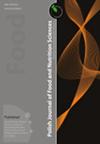Ultrasound-Assisted Extractions for Improving the Recovery of Phenolics and Charantin from Bitter Melon and for Increasing the Antioxidant, Antidiabetic and Anti-Obesity Activities of Its Extracts
IF 2.3
4区 农林科学
Q3 FOOD SCIENCE & TECHNOLOGY
引用次数: 2
Abstract
Its bioactive - pound-rich probe- bath-type ultrasound-assisted (UAE) 60% ( v/v ) ethanol distilled The com position and bioactivity of the extracts prepared using compared with those obtained by conventional extraction methods, as autoclave extraction, ethanol extraction, and hot-water extraction. the yield of the autoclave extraction was the highest, the extracts obtained using UAE and aqueous ethanol a higher total phenolic content, antioxidant activity, antidiabetic activity ( α -amylase and α -glucosidase inhibitory activi- ties), and pancreatic lipase inhibitory activity than the conventional extracts. In particular, UAE with probe system and aqueous ethanol (UAE-P-E) extracting bioactive compounds, phenolics (total phenolic content of 18.73 mg GAE/g extract) and charantin (28.56 mg/g extract). Among all extracts, this prepared by UAE-P-E showed the highest DPPH radical scavenging activity (IC 50 of 0.55 mg/mL), ferric reducing antioxidant power (250.5 μmol TE/g extract), and pancreatic lipase inhibitory activity (76.38% at a concentration of 3.0 mg/mL). These results suggest that bioac - tive compound-rich extracts from bitter melon obtained using UAE, especially UAE-P-E, are expected to have high application potential as a functional food material, and are also expected to be used as natural antioxidant, antidiabetic, and anti-obesity agents.超声波辅助提取提高苦瓜中酚类物质和Charantin的回收率及提高其提取物的抗氧化、抗糖尿病和抗肥胖活性
其生物活性为富磅的探针浴式超声辅助(UAE) 60% (v/v)乙醇蒸馏,用该方法制备的提取物与传统提取方法,如高压釜提取、乙醇提取和热水提取所得的提取物的结构和生物活性进行比较。用高压灭菌法提取的黄芪总酚含量、抗氧化活性、抗糖尿病活性(α -淀粉酶和α -葡萄糖苷酶抑制活性)和胰脂肪酶抑制活性均高于常规提取的黄芪提取物。特别是用UAE探针系统和水乙醇(UAE- p - e)提取生物活性化合物、酚类物质(总酚含量18.73 mg GAE/g提取物)和charantin (28.56 mg/g提取物)。其中,UAE-P-E提取物对DPPH自由基的清除活性最高(ic50为0.55 mg/mL),对铁的还原抗氧化能力最高(250.5 μmol TE/g提取物),对胰脂肪酶的抑制活性最高(3.0 mg/mL提取物)为76.38%。综上所述,利用UAE提取的富含生物活性化合物的苦瓜提取物,特别是UAE- p - e,作为功能性食品材料具有很大的应用潜力,有望作为天然抗氧化剂、抗糖尿病剂和抗肥胖剂使用。
本文章由计算机程序翻译,如有差异,请以英文原文为准。
求助全文
约1分钟内获得全文
求助全文
来源期刊

Polish Journal of Food and Nutrition Sciences
FOOD SCIENCE & TECHNOLOGY-
CiteScore
4.30
自引率
12.50%
发文量
25
审稿时长
20 weeks
期刊介绍:
The Polish Journal of Food and Nutrition Sciences publishes original, basic and applied papers, reviews and short communications on fundamental and applied food research in the following Sections:
-Food Technology:
Innovative technology of food development including biotechnological and microbiological aspects
Effects of processing on food composition and nutritional value
-Food Chemistry:
Bioactive constituents of foods
Chemistry relating to major and minor components of food
Analytical methods
-Food Quality and Functionality:
Sensory methodologies
Functional properties of food
Food physics
Quality, storage and safety of food
-Nutritional Research Section:
Nutritional studies relating to major and minor components of food (excluding works related to questionnaire
surveys)
-“News” section:
Announcements of congresses
Miscellanea
 求助内容:
求助内容: 应助结果提醒方式:
应助结果提醒方式:


